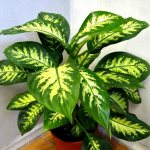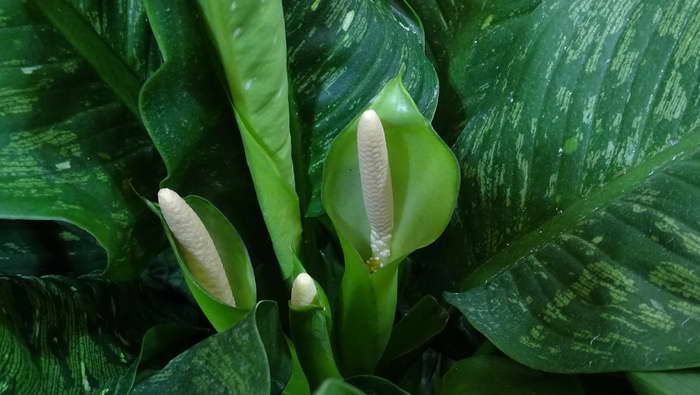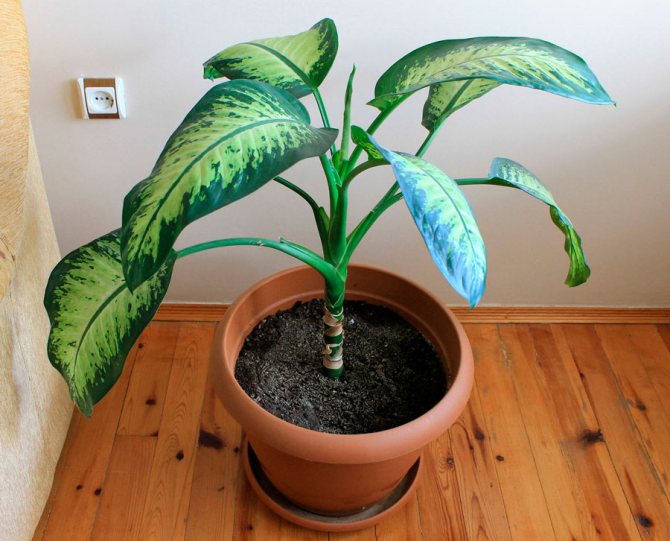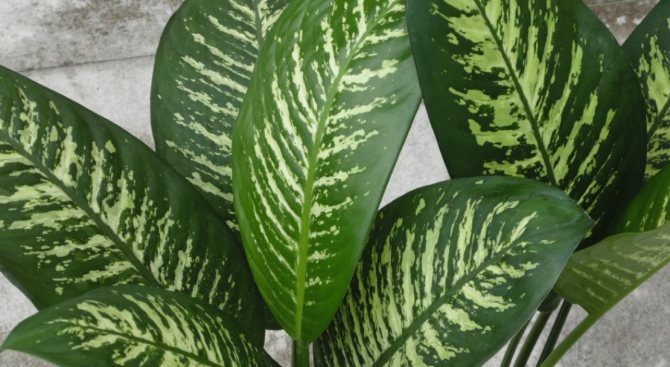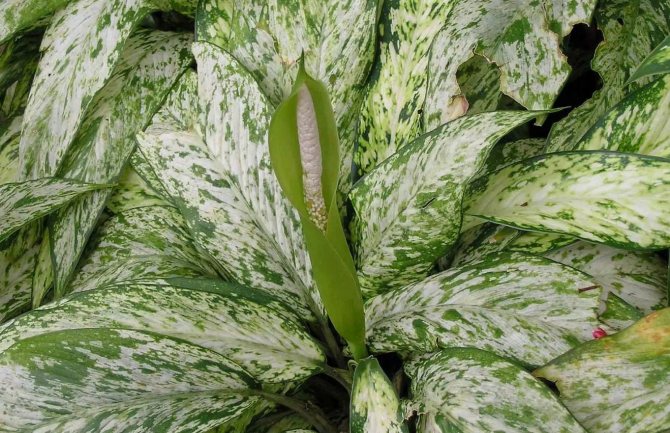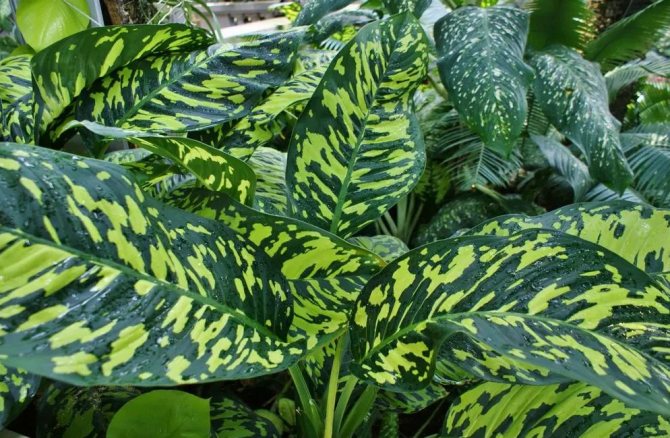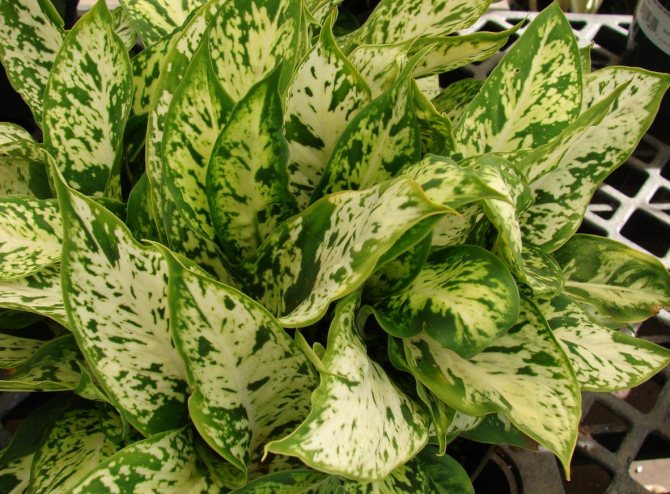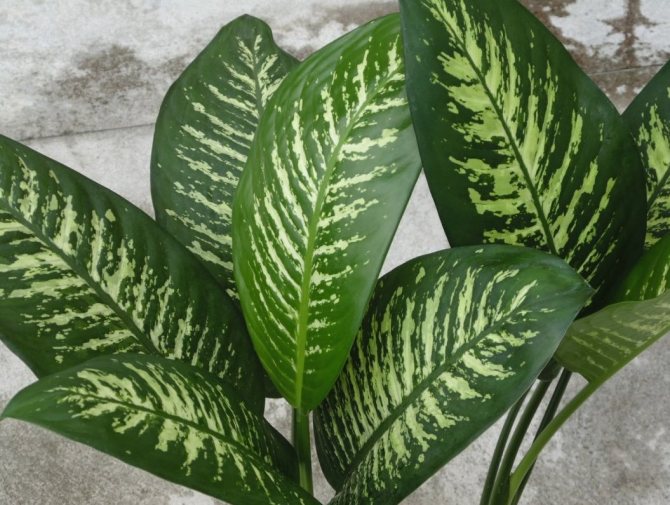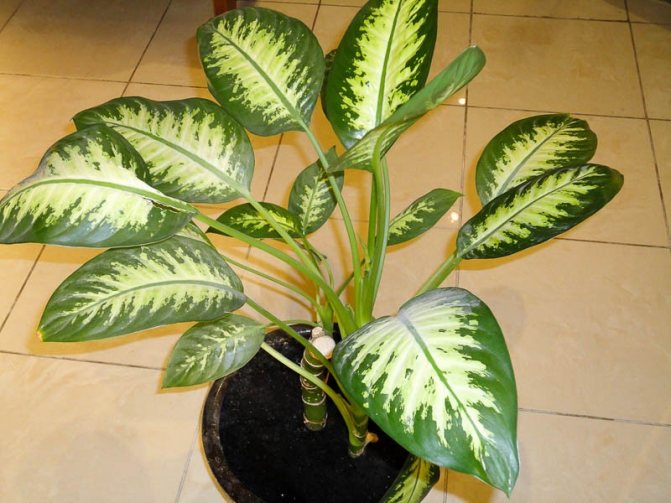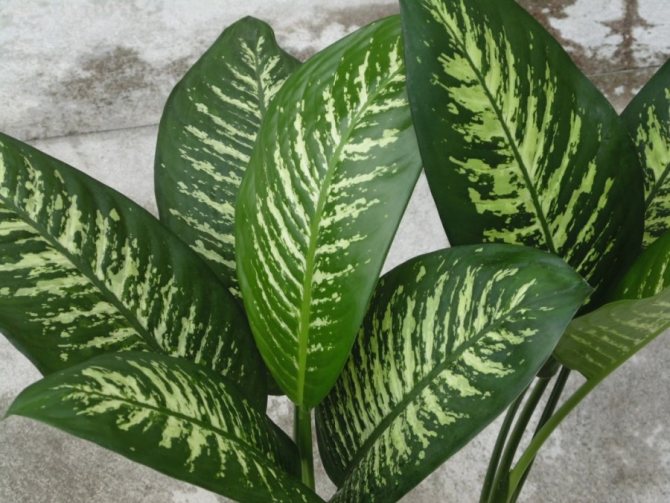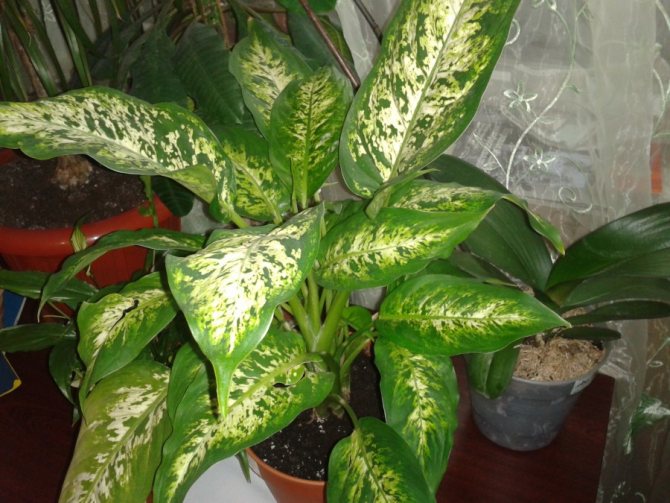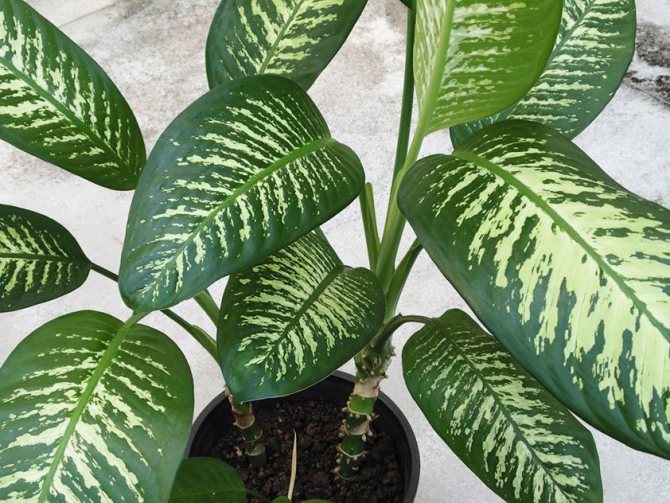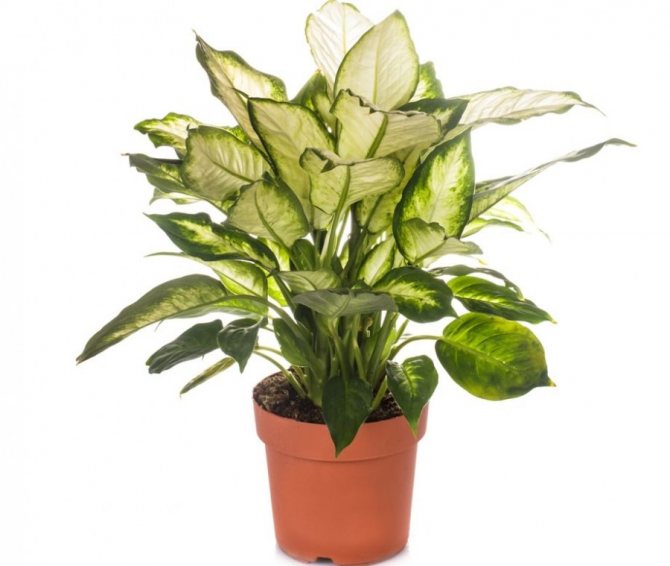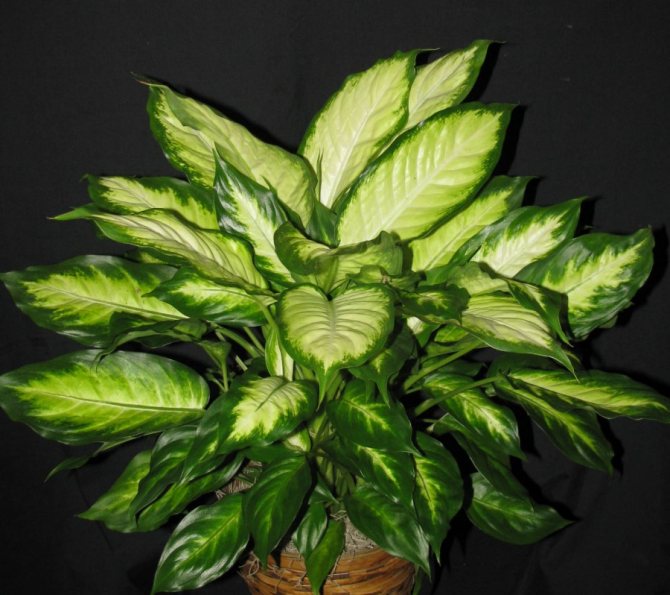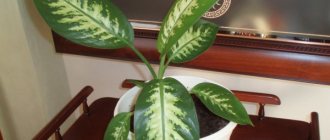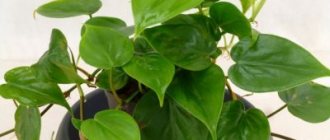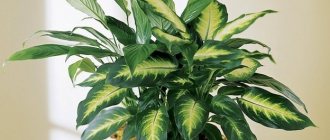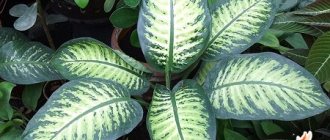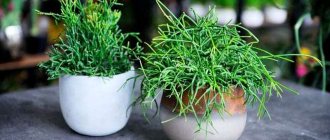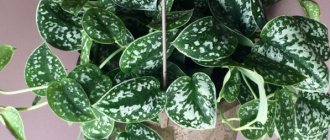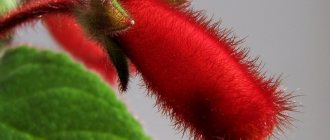In this article, we will introduce you to the types and varieties of dieffenbachia - a very beautiful flower related to decorative deciduous indoor plants. Its cob flowers look rather modest, but its variegated glossy leaves and large size of the bush make a strong impression. More than one hundred and fifty years ago, this plant from tropical thickets moved to the homes of flower growers. Diefenbachia lends coziness to any room - be it a house or a respectable institution, decorates it and refreshes the surrounding air. In addition, it is distinguished by its unpretentious care and longevity.
Dieffenbachia - description
Dieffenbachia (lat.Dieffenbachia) - a plant of the aroid family. Depending on the source, the genus includes 30-40 plant species. The homeland of these herbaceous perennials is the tropical zones of America. The genus was named in honor of Dieffenbach, a 19th century German botanist.
Dieffenbachia are evergreens with a powerful trunk and beautiful leaves, for which the genus is valued in culture. Depending on the species, dieffenbachia has a different leaf color: white, green, with stripes, spots, edging and many other different varieties and shapes. If the conditions are right, and the care is proper, then home dieffenbachia can bloom - the flower is expressed as an ear, wrapped in a greenish-white blanket.
Dieffenbachia is a very popular indoor plant, but it is quite demanding in terms of care. The plant requires regular watering and spraying, does not like drafts and sudden temperature changes. When buying dieffenbachia, you need to pay attention to the toxicity of the milky sap of the plant - it causes skin irritation, and when it gets into the oral cavity, it causes dumbness. Depending on the type and variety, dieffenbachia grow up to 1-2 m in height in just 5 years.
Varieties of dieffenbachia
On the Internet, you can find photos of many different types of this flower. Here are the most popular ones.
Spotted Dieffenbachia
The most common species. It often serves as a base for the development of new varieties with unusually effective patterns on the leaves. The surface of the leaf plates in some varieties of spotted dieffenbachia may be different. Another name for this species is painted dieffenbachia.
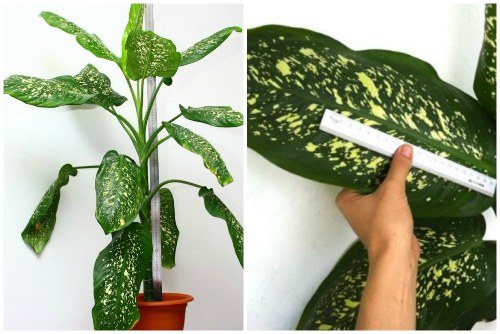
Camilla
This species has a bush form. Light lemon, almost white leaves at the edges have a bright green border.
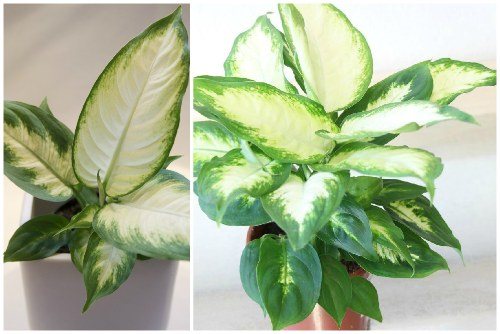

Pretty or Seguina
A plant with rounded oblong leaf plates, in the center of which there is a light pattern in the form of a herringbone. The edges of the leaves are dark green. In good lighting conditions, this contrast becomes more pronounced.
The contrast between the dark green edges and the background makes the plant very visible and attractive. In good light, the pattern is brighter and more noticeable.


Compact
Compact variety. In terms of decorativeness, it is in no way inferior to its tall brothers. Such a bush can be settled even in a small apartment.
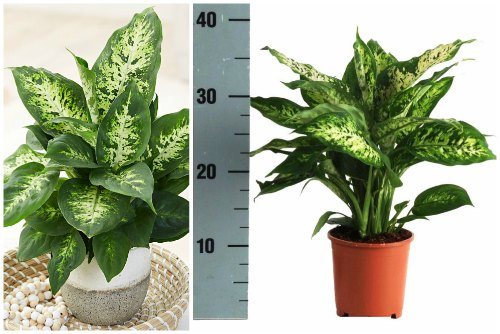

Oersted
The elongated dieffenbachia leaves of this variety are decorated with a contrasting light stripe located along the central vein.
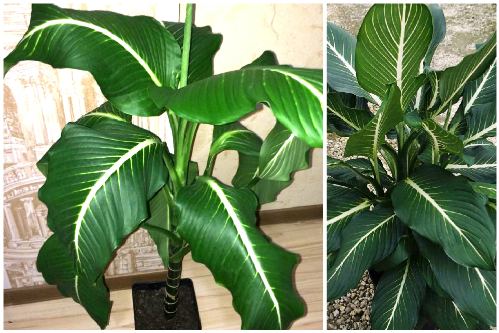

Reflector
The color of the leaves of this species is unusually bright, contrasting. Light yellow or bright green spots seem to be sprayed over the entire surface of dark green leaves.
This species is less susceptible to ultraviolet radiation, but more demanding on indoor humidity and regular watering, and is very sensitive to temperature changes.
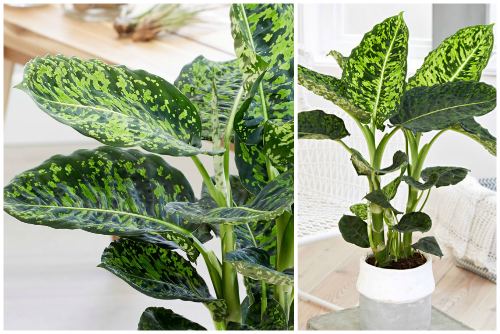

Dieffenbachia is a wonderful decoration for a winter garden, office, private house or city apartment. Thanks to their intensive growth and ease of breeding, you can quickly create a cozy corner filled with lush variegated greenery. Plants respond gratefully to a caring attitude.
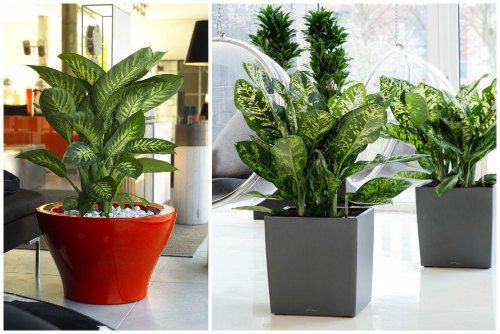

Never forget that dieffenbachia juice is toxic. It is important to follow simple precautions when caring for a plant.
In this case, breeding dieffenbachia will bring a lot of positive emotions, and, possibly, will lead to new discoveries.
Planting and caring for dieffenbachia
- Bloom: does not bloom in room culture. The plant is grown as an ornamental deciduous plant.
- Lighting: for variegated forms - bright diffused light without direct sunlight, forms with green leaves are good in partial shade.
- Temperature: during the growing season - 20-25 ºC, in winter - 18-20, but not lower than 15 ºC.
- Watering: in winter and autumn - two days after the top layer of the substrate has dried, during the period of active growth, watering should be abundant, but you need to wait until the top layer of soil in the pot dries out.
- Air humidity: increased. You will need regular spraying and weekly washing of the leaves with a damp sponge.
- Top dressing: three times a month during the growing season, a lime-free organic or complex mineral fertilizer is applied in a half dosage. Fertilizers with a high nitrogen content are contraindicated for varieties with white leaves, and they are fed with mineral fertilizers no more than once every three weeks.
- Rest period: at home, the rest period is not pronounced.
- Transfer: in the spring, as the roots fill the pot space.
- Substrate: 4 parts of leafy soil, two parts of chopped sphagnum and peat, one part of sand and a little grated charcoal.
- Reproduction: separation of the apex and stem cuttings.
- Pests: spider mites, aphids, scale insects, whiteflies and mealybugs.
- Diseases: stem and root rot and problems associated with improper maintenance and care.
- Properties: the milky sap of the plant is poisonous!
Read more about growing Dieffenbachia below.
Growing geography
Dieffenbachia belongs to the evergreens of the aroid family (5).
Homeland of Dieffenbachia
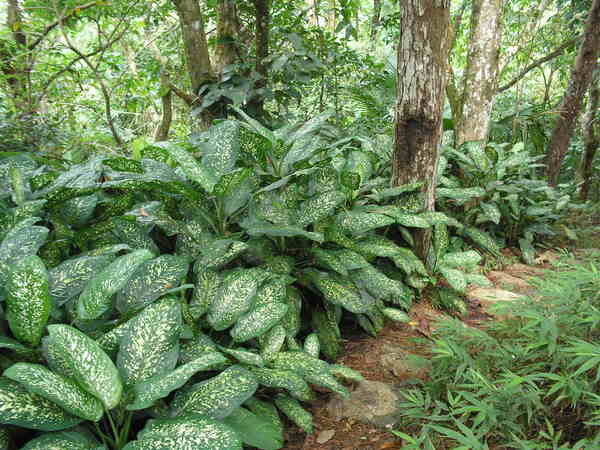

Dieffenbachia in the wild
There are many different species of this tropical plant on Earth and practically they all consider the countries of South and North America as their homeland... There are 30 species in the wild, from which the current varieties were bred.
Distribution by country
After America was discovered, the plant, along with merchant ships, spread across the lands of Oceania and the islands of the Caribbean. Therefore, first of all, pirates and traders are "to blame" for the spread of Dieffenbachia, with their help the plant moved to:
- Tahiti;
- Hawaii;
- Cook Islands.
Since the plant is practically not capricious, then in the new lands of South America, it quickly gained popularity and thanks to its rapid reproduction in a suitable climate, it has become practically an ornamental weed, growing literally underfoot in wildlife.
And much later it was brought to Europe.
Where is growing at this time


Nowadays Dieffenbachia grows all over the world
Thanks to its strong, sturdy stems and varied large foliage, the plant first spread through the greenhouses of the Old World. There in the 19th century, the first hybrids were bred with more variegated foliage... Later, the cuttings came to ordinary amateur flower growers. Today it is the most popular houseplant sold in Garden Centers around the world.Thanks to Dieffenbachia, you can make a small tropical paradise at home by choosing varieties with different leaf plate options.
Dieffenbachia care at home
Lighting
Dieffenbachias at home are not suitable for growing on southern windows, since these plants do not like direct sunlight. Species with variegated leaves need more bright diffused light than species with green ones, since with a lack of light, the leaves lose their pattern and decorativeness. Green-leaved species thrive in the back of the room, but this may require additional artificial lighting.
- Planting and caring for a daikon in open ground
Temperature
Dieffenbachia flowers at home react very badly to drafts and sudden changes in temperature. In the spring and summer, the plant needs a temperature of 21 to 25 ° C. In winter, dieffenbachia is kept at a temperature of at least 15 ° C, and the optimal temperature is 19-20 ° C.
Watering dieffenbachia
Water the houseplant dieffenbachia with soft water, let it stand for 24 hours before watering. In winter and autumn, watered gently, a couple of days after the topsoil dries. From spring and throughout the summer, water is plentifully, trying not to flood the plant, but also not allowing the earthy coma to dry out completely. Dieffenbachia sheds leaves when there is an excess of moisture in the soil.
Spraying Dieffenbachia
For the plant to grow normally, it needs to create suitable conditions. Regular spraying and weekly leaf washing are necessary. If possible, then a room dieffenbachia can arrange an outdoor shower, having previously covered the soil in the pot with cellophane wrap. If the size of the plant does not allow washing the plant in the shower, then the leaves should be wiped with a wet soft cloth.
Dieffenbachia feeding
During the period of active growth (in spring and summer), homemade dieffenbachia are fertilized three times a month with half the amount of fertilizer specified by the manufacturer. Choose only fertilizers that do not contain lime. When feeding a houseplant dieffenbachia with organic fertilizers, you need to remember that varieties with white leaves can turn green (excess nitrogen affects), especially with insufficient light. Such varieties are fed only with mineral fertilizers no more than once every three weeks.
Pruning Dieffenbachia
Dieffenbachia becomes bare over time - discards the lower leaves - and homemade dieffenbachia is rejuvenated from time to time: the upper part of the plant is cut off a couple of centimeters below the node, after which you need to wash off the protruding milky juice, wipe the cut dry with a napkin and powder with crushed coal. Young plants will grow on the remaining stem.
Dieffenbachia transplant
It is necessary to transplant dieffenbachia only after the roots have completely filled the pot. The optimal time for replanting: from late winter to late spring. With active and rapid growth, a transplant may be necessary in the summer - at this time it is better to pass dieffenbachia without disturbing the earthen lump. Both transshipment and transplantation are carried out in a slightly larger pot, a new drainage is poured. The soil must be breathable and permeable. If moisture lingers in the substrate, the roots die off, and spots appear on the leaves from the spread of infection. The substrate is slightly acidic - 4 parts of leaf, two parts of high moor peat and cut sphagnum, one part of sand. It is advisable to add grated charcoal to the substrate. Expanded clay should be poured at the bottom of the pot so that excess moisture does not linger in the soil.
- Planting and caring for a daikon in open ground
Propagation of dieffenbachia cuttings
When indoor dieffenbachia begins to bare (the lower leaves fall off), and dieffenbachia can be propagated by apical cuttings.To do this, the top of the plant with leaves is cut to a bare stem (a couple of centimeters below the top node). The apical cutting is rooted in sand, sphagnum, a mixture of equal parts of sand and peat, or in water. The container with the handle is placed in a place with bright light (but always without direct rays of the sun), the temperature is maintained at 22-24 ° C, the leaves are regularly sprayed and wiped with a damp soft sponge. A young plant is planted in a pot when the roots grow to 2-3 cm.


The remaining stem can be cut into pieces consisting of one knot, and the stump can be left in the soil, then one shoot will also go from it (you need to leave one knot on the stump). The cut parts of the trunk are dried for two days, after which they are planted in a sand-peat earth mixture in a horizontal position, covered with plastic wrap and the temperature is maintained at 25 ° C (it is better to use the bottom heating). When the cuttings have roots, they are transplanted into one of two suitable substrates: the first - 4 parts of peat and leaf soil, 2 parts of humus and 1 part of sand; the second is the same as used for transplanting (described above).
Dieffenbachia venom
The milky sap of the plant, if it comes into contact with the skin, can cause irritation, and if it gets on the mucous membranes of the mouth, it can cause swelling of the glands and tongue. You need to work with the plant carefully. When transplanting or propagating a plant, use rubber gloves and always wash your hands with soap and water after contact with the plant.
Reproduction
For propagation of dieffenbachia, apical cuttings no more than 12 cm long are used. They must be cut only with a disinfected sharp knife and after cutting it is imperative to treat the cut with an antiseptic. To do this, use charcoal or activated carbon, crushed into powder.
Remove the lower leaves from the cutting to reduce moisture loss and dip it into rooting powder ("Kornevin") with its lower end, then place it in a moistened soil. Place the pot with the handle in a warm place (+21 ° C) and cover with a glass jar on top to create a greenhouse effect. Every day, the plant should be ventilated by removing the can for about half an hour. Rooting occurs in a month and a half.
Diseases and pests of dieffenbachia
Dieffenbachia is sick. Dieffenbachia can get sick if the conditions of detention are not maintained.
Dieffenbachia falls off. If the lower leaves fall off too quickly, this indicates irregular watering. Another reason is that the pot is small for the plant.
Dieffenbachia leaf tips dry Is one of the most common problems. There can be a lot of reasons for this ailment - sudden changes in temperature, low air humidity, drafts, souring of the soil (poor drainage), spraying the plant in the dark (in the dark).
- Proven tips for growing daikon
Dieffenbachia turns pale. If the leaf begins to fade (loses brightness), there is not enough light for dieffenbachia. Also, the plant may lack trace elements, potassium and phosphorus. The third reason is an excess of nitrogen in the substrate.
New Dieffenbachia leaves grow small. If the leaves not only lose their color, but grow smaller and more deformed, then the substrate is too alkaline.
Dieffenbachia rots. If the stem loses color and becomes soft, then it begins to rot. The reason for this may be too low temperature combined with acidification of the soil. If the plant has just begun to hurt, then the decaying part is cut out, and the place of the cut is rubbed with charcoal. If this does not work out, it is better to cut off and root the top, and discard the rest of the dieffenbachia.
The lower leaves of Dieffenbachia turn yellow. If the lower leaves curl up and turn yellow in dieffenbachia, this indicates drafts or too low a temperature in winter.
Dieffenbachia leaves turn pale. The discoloration of dieffenbachia leaves can be caused by too much light or by standing in direct sunlight.
The edges of dieffenbachia leaves turn brown. The leaves turn brown. Low air temperatures or lack of moisture in the soil can lead to browning of the edges of Dieffenbachia leaves.
Dieffenbachia pests. Pests that annoy dieffenbachia are spider mites, aphids, whiteflies, mealybugs, and scale insects.
Types of dieffenbachia
Dieffenbachia leopoldii
Leaves on short stalks grow on a 5-centimeter stem. The leaves are oval, wide, up to 35 cm long and up to 15 cm wide, the central vein is white, and the leaf itself is dark green. The flower is an ear, wrapped in a white blanket.
Dieffenbachia adorable / Dieffenbachia amoena
Hardy look. The trunk is up to 1.5 m in height. Leaves up to 0.5 m in length, dark green, white stripes along the veins on the leaves.
Dieffenbachia spotted / Dieffenbachia maculata
Or Dieffenbachia picta. Stem up to 1 m in height, the length of the petioles is usually equal to the length of the leaf. The leaves are lanceolate, up to 40 cm long and up to 12 cm wide, slightly pointed at the top. The leaves are covered with white spots.

